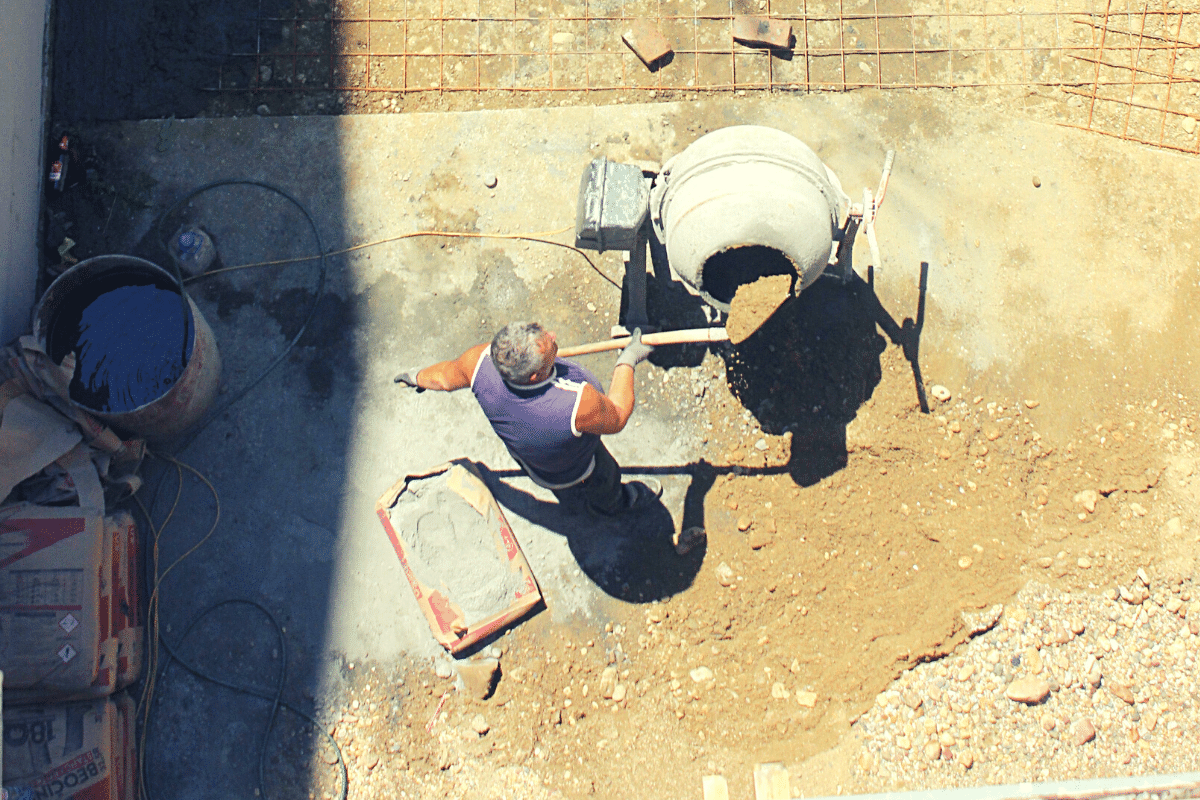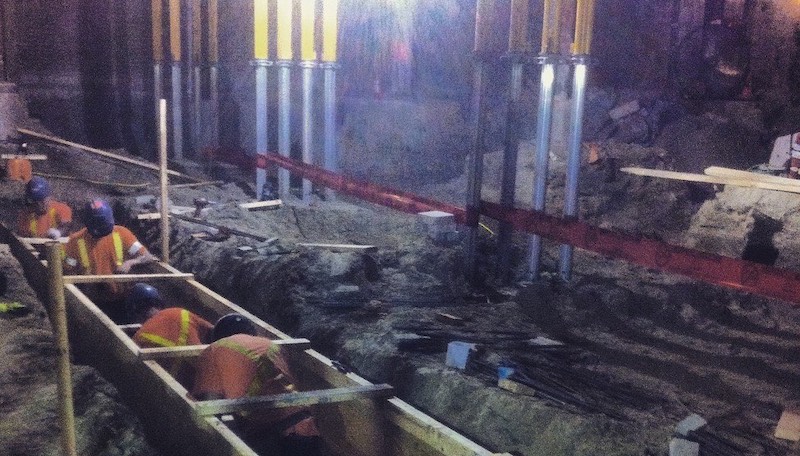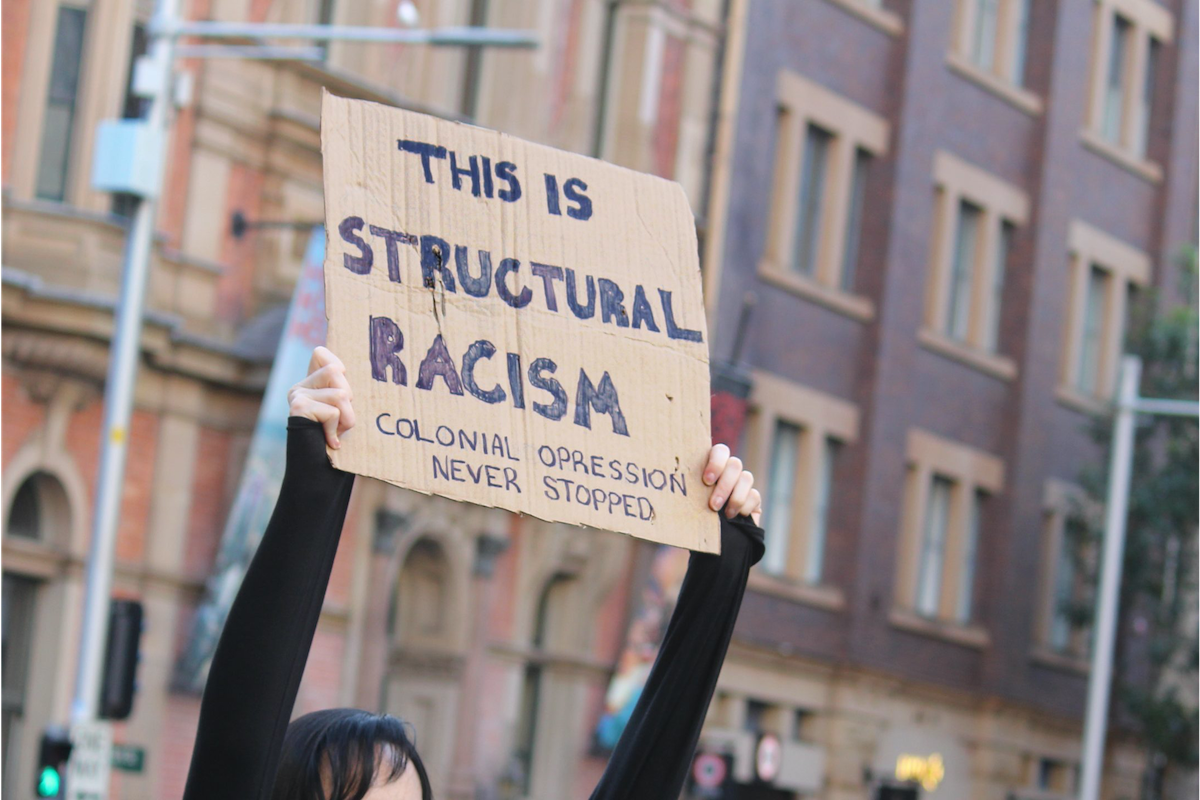Nonfiction
My Life Pouring Concrete
During my first four years of occasional construction work, from 2014 to 2018, almost 5,000 workers in this field died on the job in the United States.

The ritual was to arrive at work half an hour early, so I could gradually wake up in the car listening to the radio, drinking coffee, and eating doughnuts. I’d park my Honda Fit beside the site foreman’s pick-up truck. His morning pre-shift was like mine, except that his breakfast was vodka-soda with painkillers. Another two labourers usually arrived after I did: an irritable six-foot-three indigenous guy called by everyone, including himself, the “BFI,” which stood for “Big F-cking Indian”; and a cocaine-addled Italian who split “a gram or two with the wife” nightly, pairing it with a three-litre bottle of red wine. He claimed to sleep only two hours, which I never doubted, since he had to commute an hour to get on site at 6am. Of my colleagues, only the BFI always worked sober, having survived years of alcoholism (not to mention some prison time).
At age 20, I’d started my first week in construction, excavating a commercial space for a liquor store. The dark pits of freshly-dug soil gave the air a musty sweetness that stuck in the back of the throat. We’d spend 12-hour days digging trenches in the subterranean dark, and then fill them up with concrete. The ready mix splashed onto my skin and made my eyes burn, while men yelled monosyllabic instructions over the din of engines. The air smelled of diesel, with notes of liquid metal thanks to the welders. On break, we made our way outside, the only time we saw the sun, to immediately contaminate the fresh air with a round of cigarettes. True to stereotype, not one woman escaped our gaze. They were something to look at that wasn’t steel, dirt, dust, or rock.
This is how some men spend the majority of their lives.
I say “men” because, in my chosen subspecialty of concrete (whose ranks include those formally designated in the United States under the category of “cement masons, concrete finishers, and terrazzo workers”), the work force is 98.9 percent male. According to 2018 data (collected well before the COVID-19 pandemic), the average annual salary is about $42,000, significantly less than the national average of $54,000. In this industry, 50 is considered old. And working past 60 is almost unheard of. Most of the men I worked with had little formal education. Many had a criminal record. Men working in construction and extraction have the highest suicide rate of any industry, as well as the highest rate of opioid addiction, and (predictably) overdoses. Alcoholism rates are second only to the mining industry. It’s a rough crowd doing hard work. So you can see why employers might have difficulty addressing their gender imbalance.
Men work construction jobs because they need the money. But they also take pride in their daily work product, and the more general fact that they build and fix the concrete world that we all need. There’s usually a strong work ethic on display, too, even if it doesn’t always manifest itself as what many of us would describe as professionalism per se.

To the extent construction workers are discussed at all in the media or popular culture, it’s usually by reference to stereotypically negative attributes, such as sexist leering, foul language, and substance abuse. Unless you are embedded in this world, you’ll miss the offsetting positive aspects, including the unspoken code that exists among most crews: (1) Do the best work you can, without creating more work for others; (2) don’t shirk the dirtiest or hardest task; (3) obey your direct boss, but remain suspicious of authority more generally, especially when it walks on to the site with clean hands and nice shoes. (Young engineers tend to be particular objects of scorn); (4) never rat. If someone’s alcohol or drug problem is out of hand, let the supervisor address it. If your colleague gets fired because you blew the whistle, you may lose something more precious than a job.

While doing interviews for this article, two unionized municipal construction workers told me, off the record, “There are only two rules with Percocet: One, never talk about perkies. Two, do you have any?” The high level of opioid use among construction workers arises from the need to alleviate pain. Many workers freely offer stories about past accidents and the ensuing surgeries. In other cases, it’s a case of repetitive stress and bodily wear and tear, including slipped disks and rotator-cuff issues. Opioids are especially helpful for contract labourers who don’t have union protection or job benefits. Without work, they have no money, so they rely on pills to stay on site.
Eventually, of course, avoidance of withdrawal symptoms becomes the dominant priority. And one friend of mine fell off the workforce when he could no longer find a steady supply of pills. The symptoms of sudden abstinence, which often start with vomiting and diarrhoea, can sometimes be life-threatening. To save a colleague from unemployment, and possibly from falling into a deadly spiral, a few men relinquished some of their own pills as an act of charity, knowing the roles could be reversed one day.
On the sites I worked, Percocet went for between $3 and $5 per 5mg dose. The more potent 80 mg OxyContins went for $80. (The active ingredient in both is oxycodone.) Labourers are rarely prescribed enough by their doctors to feed their addictions, and so they buy or trade amongst one another. Some spend upward of $500 per week, and have to enter into informal buy-and-sell agreements, somewhat comparable to stock options. One supervisor habitually secured a high volume of Percocets through his monthly prescription, and would sell a portion at the beginning of the month, with the understanding that he’d buy some back at an agreed upon price when his supply ran out. He did this to prevent himself from doing all his pills at once.
During my first four years of occasional construction work, from 2014 to 2018, almost 5,000 workers in this field died on the job in the United States. But those figures include only private-sector construction work, and exclude associated suicides, accidental overdoses, as well as traffic accidents while commuting to and from work. Even according to the lowest figures, the on-the-job fatal injury count for hardhats is higher than for any other occupation, mostly because of what’s sometimes referred to by the US Labor Department as the “fatal four”: falling, getting struck by an object, electrocutions, and “getting caught in (or in between) things.”
America’s most revered professions include emergency responders: police officers, firefighters, and paramedics. During the COVID-19 pandemic, health workers of all kinds have been properly showered with gratitude as well. In 2019, however, workers in these areas lost a combined 150 lives, about one-seventh the total deaths in construction in a typical year. Even America’s soldiers have suffered fewer absolute losses than construction workers in recent years.

Soldiers and first responders enjoy an elevated status because they work to protect us from obvious threats—foreign attack, terrorism, disease. If construction is done successfully, on the other hand, there is no threat (unless you count nature, which few do, since most of us now simply take protection from the elements for granted). In addition, it is assumed that soldiers and first responders choose their jobs, whereas labourers have merely accepted theirs with resignation, because they couldn’t find anything better.
Construction workers lack the aesthetic of heroes. George Orwell observed in The Road to Wigan Pier (1937) that the main reason the working classes, coal miners, in particular, were looked down upon was not because of some abstract quality such as mind or character, but because of the way they struck the senses of more refined observers:
It may not greatly matter if the average middle-class person is brought up to believe that the working classes are ignorant, lazy, drunken, boorish, and dishonest; it is when he is brought up to believe that they are dirty that the harm is done… And in my childhood, we were brought up to believe that they were dirty. Very early in life, you acquired the idea that there was something subtly repulsive about a working-class body; you would not get nearer to it than you could help.
Orwell’s view is somewhat dated, of course. Mines and other industrial facilities now require fewer workers, and are more dependent on highly skilled technicians to operate the machines that do most of the work. In our post-industrial world, moreover, hipsters now have become enamored with certain kinds of blue-collar work. But these infatuations tend to focus on artisanal subcultures, such as fine woodworking, custom-made bicycles, or craft cideries. Day-to-day construction work doesn’t qualify: I’ve yet to encounter an ambitious student who dreams of tying rebar or pouring concrete. In fact, the lifestyle is sometimes similar to one that Orwell might recognize. There were some weeks when, after dawn-to-dusk shifts, I would climb into bed without showering, in my dirty and smelly workwear, from sheer exhaustion, and for the convenience of not having to change in the morning.

In fiction, labourers have been featured prominently in niches such as communist proletariat literature and gay romance. Though neither present any kind of realistic image of working life. On television, arguably the most popular show with a blue-collar construction theme is the children’s cartoon, Bob the Builder (which portrays the life of a building contractor with the same level of accuracy as an anthropologist might find in a plotline from Dora the Explorer). On the silver screen, similarly, we got Emmet from The Lego Movie in 2014. One of the few memorable construction-worker heroes in a Hollywood movie aimed at adults was Douglas Quaid, played by Arnold Schwarzenegger in Total Recall. The 1990 movie had been adapted from Philip K Dick’s novel, We Can Remember It for You Wholesale (1966), whose protagonist was an office clerk. It was only because of Schwarzenegger’s physique that a blue-collar back story was substituted.
In music, there was once a fashion for socialist propaganda songs, including those produced by the Wobblies, short-hand for the International Workers of the World Union. Perhaps the most famous was Joe Hill’s The Preacher and The Slave (1911). As consolation for their meager rations and impoverished lives, a preacher assures workers, they’ll get food in heaven—which is how we got the expression “pie in the sky”:
Long-haired preachers come out every night
Try to tell you what’s wrong and what’s right
But when asked about something to eat
They will answer in voices so sweet
You will eat, you will eat, by and by
In that glorious land in the sky, way up high
Work and pray, live on hay
You’ll get pie in the sky when you die, that’s a lie
(In Animal Farm, Orwell borrowed a similar concept, with Moses the crow encouraging farm animals to ignore their agonies on Earth and instead imagine the pleasures to be enjoyed in the great beyond, a land that he promised was real, and which he called “Sugarcandy Mountain.”)
The revival of Zionism in the 19th century provides one notable cultural genre in which the common labourer received heroic treatment in a way that transcended merely socialist tropes. This included the so-called Muscular Judaism movement presented by Zionist leader Max Nordau as an answer to caricature of Jews as meek and cowardly parasites who got by on guile instead of effort. Long before the rise of the Nazi menace, he argued in a 1903 article (Muskeljudentum, “Jewry of Muscle”) that physical strength was essential to enable Jews both to combat anti-Semitic prejudice and develop a revived national identity. He called on the diaspora to “let us once more become deep-chested, sturdy, sharp-eyed men.”
A second influence was Avoda Ivrit, or “Hebrew Labour,” which had a mystical element. Championed by Zionist ideologue A. D. Gordon, this movement held that Jewish immersion in the holy land could be properly achieved only through manual work. Of course, these labourers were not like the modern wage-earners I’ve written about here. These were self-sustaining agrarians who channeled their efforts into an explicitly nationalistic, collective project. However, Israel’s founding fathers did at least give workers their proper due alongside other callings.
A few years ago, while walking with a friend who had worked alongside me at the same construction company, we saw a car veer off the road and smash through the wall of a convenience store. Working a few blocks away, members of a construction crew heard the accident and sprinted over. They pulled the female driver out of her smoking car and laid her out on the sidewalk. These were the only people to help before the ambulance arrived, while the other, more “respectable,” bystanders held up their phones to record everything. My friend reflected, “It makes me proud to have worked construction.”
This sentimental bit of camaraderie stuck with me, but only until the next day. Back on site, a co-worker noticed a girl across the street while we were on break. He shouted my way, “I’d f–ck the hole off of her.” If anyone had been filming him, it’s a scene that would have gone viral among those with clean hands and nice shoes. In Orwell’s day, the privileged set had to get up close and personal to develop their disdain for the working class. These days, thanks to Twitter, they can do it without getting out of bed.







